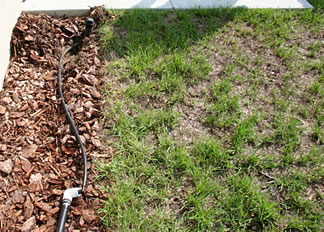No permanent irrigation
- Home
- /
- Technical Manual
- /
- Irrigation system criteria
- /
- General design
- /
- No permanent irrigation
Background
Unirrigated landscape areas continue to gain traction as a significant water efficiency practice for water conservation. This practice relies on careful design of landscape beds and turf grass/ground cover areas, and correct installation and establishment of site-appropriate plants. These types of well-designed landscapes should survive with minimal irrigation beyond establishment and can often be limited to hand watering during dry periods.
Most new landscapes require some establishment irrigation. Strategies for applying establishment irrigation vary widely and should be both effective and removed in a timely manner. This document can assist you in designing a temporary system to establish a landscape.
Requirements and certification
Landscape has reduced or no permanent irrigation system.

| Percent of Landscape | Silver | Gold | Commercial/Institutional |
|---|---|---|---|
| 100 | NA | 40 points | NA |
| 75 | NA | 30 points | NA |
| 50 | NA | 20 points | NA |
| 25 | NA | 10 points | NA |
Temporary irrigation systems are permitted for landscape plant establishment. After establishment, plants should be able to survive on rainfall alone during normal conditions. Therefore, an irrigation system must be verified as temporary in an area that receives credit for having no permanent irrigation.
Temporary irrigation components must comply with the following:
- Not be supplied by buried polyvinyl chloride (PVC) pipe
- Be separate from any type of permanent irrigation system
- Have written instructions for removal, including removal date
Applicants shall notify the Florida Water Star Inspector of the temporary irrigation disconnection. An email will suffice to meet this requirement.
Areas that do not have permanent in-ground irrigation should be indicated on the irrigation drawing.
The Inspector shall verify that no permanent irrigation system is installed and establishment irrigation systems are designed for removal.
